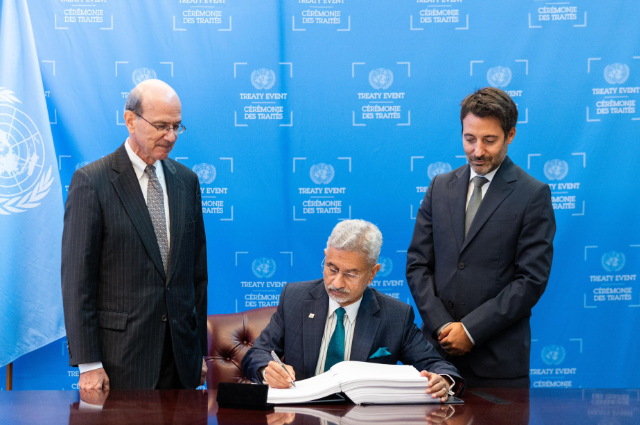India's External Affairs Minister, S. Jaishankar, who is currently on an official visit to the United States had taken part in a significant discussion where he highlighted key strategies for achieving global development. One of the primary points he raised was the need to democratise the global economy. This concept involves making economic opportunities more accessible to all nations and ensuring that economic benefits are shared more equally across societies, especially in the context of developing nations.
The Role of Mobility and Skills in Sustainable Development
Jaishankar also emphasized the importance of enhancing mobility. This involves enabling the free movement of people, goods, and services across borders which is essential for economic growth and international cooperation. Alongside this, he stressed the critical need for imparting skills, particularly to the workforce in developing countries. By equipping people with the necessary skills, nations can foster innovation, boost productivity, and ultimately contribute more effectively to global development goals.
Building Connectivity to Achieve the SDGs
Another major theme of Jaishankar's discussion was the need to build robust connectivity between countries. Whether through physical infrastructure like roads, ports, and telecommunications or through digital networks, enhancing connectivity is crucial for achieving the United Nations' Sustainable Development Goals (SDGs). By fostering stronger connections, nations can better collaborate on solving global issues like poverty, inequality, and climate change.
A New Development Paradigm
The discussion Jaishankar participated in was organised by the Observer Research Foundation (ORF), under the title "Tiger’s Tale: Crafting a New Development Paradigm." This title reflects the broader conversation about reshaping how the world approaches development in a way that is inclusive, innovative and aligned with the SDGs. Jaishankar’s contributions to the dialogue highlighted India's growing role in shaping global development policies and its commitment to working towards a more equitable and sustainable future.
Through his participation in this important forum, Jaishankar reinforced the idea that democratising the economy, enhancing mobility, imparting skills, and building connectivity are essential pillars for achieving the United Nations' Sustainable Development Goals. His insights demonstrate how critical it is for countries to work together in these areas to create a more inclusive and sustainable global future.
World Leaders Adopt ‘Pact for the Future’: A Bold Step Towards Global Cooperation
On September 22, 2023, world leaders gathered at the United Nations Headquarters in New York and collectively adopted the ‘Pact for the Future.’ This landmark decision represents a pivotal moment in international collaboration as it incorporates key agreements like the Global Digital Compact and the Declaration on Future Generations. The adoption of the Pact signals a renewed commitment by countries to tackle modern-day challenges with a forward-thinking approach, according to a UN press release.
A Historic International Agreement
The ‘Pact for the Future’ is being hailed as one of the most comprehensive international agreements seen in recent decades. Its main goal is to ensure that global institutions remain capable of addressing the rapidly evolving issues of today's world. With the increasing pace of technological advancements, climate change, and geopolitical shifts, there is a pressing need to modernize and strengthen international cooperation. This Pact symbolizes the world's recognition of that necessity.
Guterres’ Call for a New System
UN Secretary-General Antonio Guterres stressed the urgency of moving beyond outdated global systems. He powerfully captured this idea in his statement, "We cannot create a future fit for our grandchildren with a system built by our grandparents." His remarks emphasize that the current systems, which were designed in the past are no longer adequate to handle the complexities of today's challenges. Guterres sees the Pact as a vital step toward reinventing global governance to meet contemporary needs.
Opportunities for the Future
At the Summit of the Future, where the Pact was officially introduced, Guterres pointed out that this agreement along with its accompanying initiatives offers new opportunities for international cooperation. The Pact not only addresses current problems but also taps into "untapped possibilities" that could shape a better future for generations to come. This vision aligns with the broader goals of the United Nations to create a fairer and more sustainable world.
Support from the General Assembly
Resonating Guterres’ sentiments, Dennis Francis, President of the General Assembly emphasized the significance of the Pact. He described it as laying the groundwork for a global order that is "sustainable, just, and peaceful." Francis' endorsement further highlights the importance of the Pact in establishing a long-term framework for cooperation that benefits all nations and peoples.
Commitment to International Law and Cooperation
The adoption of the Pact for the Future is not only a commitment to address pressing global issues but also a strong affirmation of faith in the United Nations, the international system, and the principles of international law. It demonstrates that countries remain united in their desire to work together to secure a stable, equitable, and peaceful future for all.
In conclusion, the Pact for the Future marks a critical moment in global diplomacy. As world leaders align themselves with this bold initiative, they acknowledge the need for fresh approaches and stronger cooperation to navigate the complexities of our changing world. This agreement serves as a beacon of hope for a more inclusive, effective, and just international order.
. . .
References:

